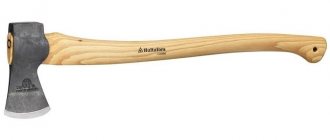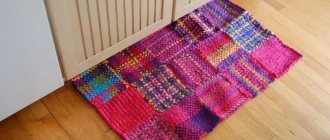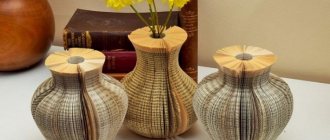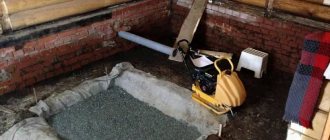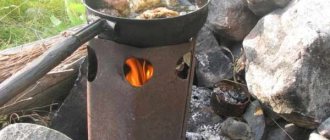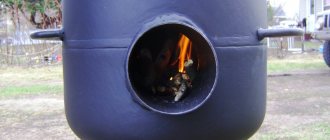Dachas purchased back in Soviet times are real treasure troves: in the attic, in the utility room or right on the street you can find many rare or simply useful things for the household. For example, an old cast-iron bathtub, discarded as unnecessary, most often plays the boring role of a container for watering plants. It will bring much more benefit if, with the help of skillful hands, it turns into a heat source or cooking unit. We offer a detailed description of how to make your own oven from a bathtub, in which you can stew meat and bake pies.
Advantages of cast iron
A stove made from a cast iron bath will last almost forever. Even enamel will not burn out quickly. In Soviet times, enamel was applied in two layers. The enamel contained quartz sand. After coating with enamel, the product was baked in an oven at a temperature of more than 800 degrees. The sand melted, and this coating served for decades. The enamel could only be damaged by a strong blow from a heavy object.
Cast iron bathtub is durable enough to make a stove out of it
In addition, cast iron has a high heat capacity, accumulates and releases heat well. Not afraid of corrosion. The industry produces fireboxes and grates from cast iron, since it does not burn out for a long time, unlike steel. But cast iron is a rather brittle metal.
Types of structures
They differ in structure and operating principles. Let's look at each type in more detail.
Open
The stones are laid on top of the stove structure and are not covered with anything. Due to this, the steam room warms up faster, reaching temperatures of up to 100 degrees. But the humidity in the room is low, so the heat turns out dry.
The product consists of three parts:
- fireboxes;
- compartments for stones;
- containers with water.
There should be few stones, otherwise the top layer will not warm up well and the steam room will not be warm enough.
To increase the level of humidity and the release of water vapor, the hot stones are simply watered. One or two ladles will be enough - this will give up to 15% humidity.
To increase the level of fire safety and reduce the risk of burns, it is recommended to lay fire-resistant bricks around the walls of the furnace or make a partition made of wood.
To heat a sauna, it is important that as much of the stove area as possible is in contact with the air space. This contributes to faster heating of the air in the steam room
Closed (lined with brick or stone)
If wood fuel is chosen for heating, you will have to prepare large reserves in advance. Such a stove takes a long time to reach the desired temperature, but, having reached the desired level, gives good heat transfer and retains heat for a long time.
Closed structures are great for large baths, where there is not only a steam room, a wash room, a dressing room, but also a relaxation room.
One of the advantages is closed stones. Therefore, there is no risk of getting burned.
In factory economical models, the stove has a double casing with a gap for air exchange between the walls.
Combined
For most manufacturers, the design consists of a high box with gratings and double valves (performs the function of a firebox). A chimney pipe emerges from the neck of the box. Stones are placed in the neck here.
There are devices available for sale with combined fuel types:
- gas-wood;
- electric wood-burning.
They do not need to be constantly monitored. Simply adjust to the desired temperature.
By design they are divided into 3 types:
- Monoblock. With heat exchanger, combustion chamber. Gas burner of a fixed type, covered with a steel sheet.
- Paired. They have two separate combustion chambers for wood and gas.
- Reconfigurable. Universal device. Can be modified for each fuel.
The first two types do not need to be reconfigured, since you can switch from one type of fuel to another.
Gas is used as main gas or liquefied in cylinders.
The electric-wood-burning design allows you to successfully heat the bathhouse using electricity or wood (optional). Moreover, firewood is considered the main raw material. When they burn out and the temperature drops, the electric heater automatically starts working. There are two heating elements on the sides of the product. Such stoves operate on a 220 W network, with a three-phase voltage of 380 V.
The owners can choose which fuel to heat the bathhouse with. But such designs are many times more expensive than simple wood-burning stoves.
Cutting the bathtub
It is best to saw the bathtub outdoors, after turning it upside down. Cast iron is a brittle metal, so the procedure requires care. The cutting is done with a grinder. Buy several cutting discs at once. We make markings, and then lightly cut the enamel along the line so that when a full cut is made, chips do not form. We saw through the cast iron at a slight angle and make sure that the tool does not heat up. We take breaks. To prevent the halves of the sawn tub from pinching the disk at the final stage of cutting, place supports made of wood or brick along the edges of the cut.
Bathroom cutting is done with a grinder
Preparatory stage
To make a stove from an old bathtub, you will need the following materials:
- the bath itself;
- Red brick;
- cement, sand, clay;
- crushed stone;
- steel sheet with a thickness of at least 4 mm;
- lattice or perforation;
- finished door with frame and hinges for the firebox;
- steel pipe for chimney;
- boards for formwork;
- roofing felt or polyethylene for waterproofing.
The cast iron bath for the stove needs to be cut in half.
Tools needed to complete the work:
- shovel, trowel, spatula;
- metalworking tools;
- electric drill with drills;
- grinder with high-quality cutting discs;
- measuring and marking tools;
- mounting gun for working with sealant;
- welding machine.
In preparation for work, it will be necessary to transport the old bathtub to the place where the stove is manufactured. Considering its large weight and the need to cut it in half, it would be more correct to make the cut before transportation.
Correct cut
The material of the font, which is to be sawed in half, is very fragile. Therefore, we must take this stage of work very responsibly:
- Turn the bathtub upside down and secure it in a stable position.
- Mark the cutting line taking into account the width of the cutting tool.
- Slowly, strictly according to the markings, make an incision along the entire line. This will destroy the protective layer of enamel, and when cutting, it will protect the cut end of the cast-iron font from chipping.
- Carefully, slowly, taking pauses for the tool and the cast iron being processed to cool, we will cut the bath in half. When carrying out such work, it is important to remember safety measures: use safety glasses and a respirator or gauze bandage.
It is advisable to install such a heavy building on a monolithic foundation
Furnace foundation
The type of foundation depends on the total weight of the furnace:
- A brick base is suitable for a light stove. The bricks are laid on edge and bonded with mortar. Cement grade for binder mortar is not less than M300;
- for a heavy furnace weighing more than 700 kg, a self-leveling foundation with a depth of at least 50 cm will be required. Formwork is made and filled with liquid concrete with or without filler. The filler will be fine broken brick or crushed stone.
The stove can only be built on a strong and heat-resistant base.
The top of the base is placed flush with the floor or 15 cm below the floor level. To protect the base from moisture, the bottom and walls of the formwork are covered with roofing material and all joints are coated with bitumen.
Advice. The base should protrude 50 cm beyond the boundaries of the stove. In front of the combustion chamber, 1.2 m of space should remain free.
Calculation of basic parameters (with drawings and dimensions)
High efficiency of a potbelly stove can only be achieved if all the main design parameters are correctly calculated.
Pipe
In this case, the diameter of this element is very important. The throughput of the chimney should be less than the productivity of the furnace firebox, which is the main distinguishing feature of a potbelly stove. This will allow warm air not to immediately leave the stove, but to linger in it and heat the surrounding air.
It is very important to make an accurate calculation for it. The diameter should be 2.7 times the volume of the firebox. In this case, the diameter is determined in millimeters, and the volume of the firebox in liters
For example, the volume of the combustion chamber is 40 liters, which means the chimney diameter should be about 106 mm
In this case, the diameter is determined in millimeters, and the volume of the firebox in liters. For example, the volume of the combustion chamber is 40 liters, which means that the chimney diameter should be about 106 mm.
If the potbelly stove provides for the installation of grates, then the height of the firebox is calculated without taking into account the volume of this part, that is, from the top of the grate.
Screen
It is very important to force the hot gases not to cool, but to burn out completely. In addition, the fuel must burn through partial pyrolysis, which requires extremely high temperatures. A metal screen located on three sides of the stove will help to achieve a similar effect.
It should be placed at a distance of 50–70 mm from the stove walls, due to which most of the heat will return to the stove. This air movement will give the necessary high temperature and protect against fire.
A metal screen located on three sides of the stove will help to achieve a similar effect. It should be placed at a distance of 50–70 mm from the stove walls, due to which most of the heat will return to the stove. This air movement will give the necessary high temperature and protect against fire.
The screen of a potbelly stove made of red brick is capable of accumulating heat
Litter
It definitely has to be there. There are two reasons for this:
- some of the heat is radiated downwards;
- the floor on which the stove stands gets hot, which means there is a risk of fire.
The litter solves these two problems at once. As such, you can use a metal sheet with a projection of 350 mm (ideally 600 mm) beyond the contour of the furnace itself. There are also more modern materials that do an excellent job of this task, for example, a sheet of asbestos or kaolin cardboard, at least 6 mm thick.
You can use an asbestos sheet for bedding under a potbelly stove.
Chimney
Despite all the calculations, gases sometimes escape into the chimney not completely burned out. Therefore, it must be done in a special way. The chimney consists of:
- the vertical part (1–1.2 m), which is recommended to be wrapped in thermal insulation material;
- hog (slightly inclined part or completely horizontal), 2.5–4.5 m long, which should be 1.2 m from the ceiling, which is not protected with heat-resistant materials (1.5 m from the wooden surface), from the floor - by 2.2 m.
The chimney must be vented to the street
Furnace No. 1
This version of the stove is capable of heating a bathhouse of 7 square meters. m to 80 degrees in just a couple of hours. To build a stove you will need scrap metal: a cast iron bath, a gas cylinder and a metal drum from a conveyor belt with a diameter of 40 cm. The drum can be replaced with a gas cylinder or pipe - this will be the combustion chamber. The sequence of work is as follows:
- A concrete foundation is being poured for the future furnace.
- The end of the bathtub is cut off.
- We make a combustion chamber: holes are drilled at the bottom of the drum. A box is welded to cover the holes and serve as an ash pit.
- We put the door on the firebox. You can use this spare part from an old stove.
- A gas cylinder is welded vertically at the opposite end of the drum.
- Now the resulting structure is placed in the bath.
Brickwork around the bathtub - A chimney pipe is welded to the cylinder.
- Lay the foundation with bricks to the height of the bathtub. Clay mortar is used for binding.
- After the masonry has dried, it is decorated with ceramic tiles. Tile adhesive is selected that is heat-resistant.
- Stones with a fraction of 7 to 15 cm are poured into the bathtub. Granite or pink quartzite. The stones quickly gain temperature and give off heat for a long time. Quartzite releases chemical compounds into the air that normalize blood pressure and metabolism. This bathtub can hold approximately 350 kg of stones. Bathhouse technologists claim that this number of stones is enough for a bathhouse of 10 square meters. m.
Advice. If you weld a flat metal platform to the cylinder, you will get a stove for heating the kettle.
Finishing
The finishing of the stove plays a fairly important role, but not the key one. Still, finishing is worthwhile for several reasons, including:
- Longer heat retention period;
- Prevention of unintentional burns;
- Attractive appearance of the product.
Clay, sand mixture and much more can be actively used as finishing materials. Ceramic tiles are also often used, which give the bath an unforgettable appearance and a memorable external texture.
If you plan to additionally paint the stove to give it an attractive appearance, then you should use specialized heat-resistant paints for metal!
Furnace No. 2
From a cast iron bath sawn into two parts you can make a combustion chamber for a sauna stove. You will need one half, the second can be used for the fireplace.
- We are laying out the foundation.
- We install half of the bathtub with the dome up. The cut edge is inserted into the wall from where the firebox will be produced. The rest of the bath remains in the steam room.
The process of building a stove from half a cast iron bath - We fill the hole with a brick wall, into which we build the doors of the combustion chamber and the blower.
- Now we build a brick wall around the perimeter of the bathtub, flush with the bathtub. The distance from the bathroom to the wall is taken from 8 to 15 cm.
- We fill the space between the cast iron container and the brick wall with stones after the brickwork has completely dried. The stones will heat up and give off heat.
The remaining half can be used to build a fireplace. Cast iron can easily withstand brickwork if you line the fireplace with an arched vault. Moreover, for this you do not need to make a complex template from plywood. The front part is decorated with a portal. The chimney is removed. You can make the fireplace closed by installing a transparent door on the firebox and admire the flames.
Advice. Cast iron and red ceramic bricks have different coefficients of thermal expansion. Therefore, when constructing brick walls, expansion joints are provided, which are filled with asbestos or fire-resistant basalt cardboard.
Preparing tools
You will need tools for metal processing and masonry construction. To cut a cast iron bathtub, sand its edges, and make holes for fasteners, you will need:
- laser level, plumb line, tape measure, marker - for marking;
- grinder with a set of circles (for cutting metal - 125 mm in diameter and 1 mm thick, for grinding);
- files with coarse and fine notches, sandpaper;
- electric drill, drills 9-11 mm;
- hammer, pliers, metal cutters.
In addition to metal parts, there will be brickwork at the base of the structure, so you will need a nozzle for mixing cement mortar, a container for it, a trowel, and a spatula.
If you do not use an angle grinder all the time, you can rent it
Furnace No. 3
The third version of the stove is often used as a garden barbecue and for cooking in the summer. If the upper chamber is filled with stones, then such a design will replace a traditional stove in a small bathhouse, so we will not ignore this model.
- The foundation for the furnace is being poured.
- The bathtub is sawn into two identical components.
- Supports are placed on the foundation if you want the stove to be higher.
- The first half of the bath is installed. A sheet of metal with a thickness of at least 5 mm is laid on top, which will completely cover the upper and lower compartments and serve as a hob.
Construction of a barbecue stove from a cast iron bath - We cut the chimney pipe into the sheet and weld it along the contour.
- We install the second half on top with the bottom up, having previously cut a hole for the chimney.
- We glue the metal sheet and the halves of the cast iron device with high-temperature sealant. This will prevent smoke from entering the upper chamber.
- We clamp both parts with clamps and drill holes along the contour for 10 mm bolts. We fasten both parts of the bathtub and the metal sheet.
- We lay a brick pedestal under a three-wall oven.
- The grate is installed 15 cm from the bottom of the combustion chamber. If the grate size is small, then two corners are welded to install it.
- The front part is covered with a sheet of metal or brickwork with a door installed opposite the combustion and ash chambers.
Finished product from cast iron bathtub and sheet metal - A metal shutter is made according to the size of the upper chamber. In this form, the chamber can be used as an oven.
- Now all that remains is to give the product a noble appearance: cover the brick with tiles or plaster.
Such non-standard designs are easy to manufacture and require minimal financial costs. An item that has served its purpose will get a second life, and you will receive a convenient and practical stove that will serve you faithfully for many years.
List of required materials
Several items made of cast iron (if not, then stainless steel will do):
- cast iron bathtub “old school”;
- grate;
- stove with burners or metal sheet (5 mm or thicker);
- door (beautiful forged or just standard).
Other metal elements needed include corners for fixing the grate, fastening bolts with nuts, a chain-link mesh to reinforce the clay layer, and a pipe for making a chimney (diameter from 100 mm to 120 mm).
Ready-made oven doors
The masonry is made of refractory bricks, fastening the rows with clay-sand mortar. The amount of brick depends on the size of the structure. If you plan to finish the device externally with ceramics, you should purchase tiles and heat-resistant adhesive, as well as heat-resistant sealant. Don’t forget about protective equipment – thick clothing, goggles or a mask, work gloves.
Sauna stove made of cast iron bath: photo
Other uses
An old bathtub can serve well the owner of a country house or cottage, you just need to show a little imagination. Often, an old plumbing device is used in the following ways:
- Swimming pool for children. The usual inflatable pool is not the most practical thing; it can easily be replaced with a bathtub, not forgetting to install drainage at the drainage point; subsequently, such a pool can easily be transformed into an artificial reservoir.
- Design element. If you combine a flower bed and a table, then such an item can be safely placed on the terrace and admire the lush blooms in any weather.
Table for a creative person Source pinterest.ca
For those who like to cook. The streamlined shape is ideal for creating a barbecue or stove; You can also get a mini-cellar or hiding place.
When a bath doesn't spoil the view Source pinterest.com
Compost container. The bathtub is equipped with a reliable, tight-fitting lid to prevent unpleasant odors from spreading.
An alternative to a compost bin Source gjcleverley.com
Benefits received
It turned out to be quite possible to make a stove from a cast-iron bathtub with your own hands, but not so easy. There is excavation work, bricklaying, cast iron cutting, welding, and even finishing. Not a weak set of tasks. But as a result I:
- Gave a “second life” to an old item that had already served its purpose. There is always some joy in this of a small victory over time itself, which mercilessly treats everything in our world;
- I diluted the country interior with an attractive-looking design. Of course, it’s still worth covering it with tiles, but even now the created structure fits very organically into the design of my suburban area;
- a lot on the materials used . Having a working solid fuel stove on your household is much more profitable than getting pennies for accepting ferrous metal for a cast-iron bathtub. And for the most part, I found everything else that I needed to realize my plan;
- I got the opportunity to use solid fuel for cooking , saving gas and electricity, the availability of which in some suburban areas can be a big problem;
- I was finally able to cook dishes that required the special conditions of a real Russian oven, which the erected structure now provided me with;
Even simple bread in this oven turns out incredibly tasty and crispy
- I began to see friends on the threshold of my dacha much more often , wanting to try something delicious in the hot weather. In addition, they never come empty-handed; the end result is a wonderful feast.
The lion's share of the table set for guests at the dacha is cooked in a cast-iron oven

